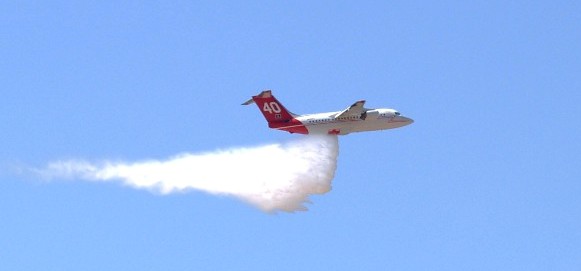
The Washington post pointed out in an article on Sunday that the 18 large air tankers on contract in the U.S. have an average age of about 50 years and are overdue for replacement.
The article hits on most of the same issues that we have written about at Wildfire Today on two occasions:
- Are we running out of air tankers? in 2009, and
- Cheap air tankers cost lives in 2010
When two large air tankers crashed in 2002, killing five crew members, the U.S. Forest Service culled the fleet of 44 large air tankers, weeding out the most vulnerable, and the ones most susceptible to metal fatigue and other issues that compromised safety when flying in mountainous terrain, in and out of canyons. Today there are only about 18 large air tankers on exclusive use contracts, a 60% reduction from 2002. And this year the USFS is refusing to offer exclusive use contracts for Very Large Air Tankers, the DC-10 and 747.
In the nine years since the 2002 crashes and reduction in force of the air tanker fleet, the USFS has commissioned multiple reports about how to modernize the fleet. Deadlines have passed with little or no action taking place that would actually replace the aircraft.
Two private air tanker operators, Neptune and Menden, are both engaged in projects to retrofit 4-engine jet airliners, BAe-146 aircraft that are much younger than the the 50-year old air tankers now flying. Neither of them have passed muster with the Interagency Air Tanker board and have yet to drop on a fire.

The USFS is saying that later this year they will ask Congress for the funding to either buy new air tankers, or pay someone to retrofit used aircraft.
Here is an excerpt from the Washington Post article:
…Tom Harbour, national fire director for the Forest Service, said the secretary of agriculture will take a funding plan to Congress in August.
“We have good data on effectiveness and use,” Harbour said. “There’s always more data that we can collect to make a more compelling case.”
But why has it taken nine years since the 2002 crashes?
“Identifying the right air tankers and processing them is a very complex issue,” said Jeff Jahnke, Colorado’s state forester and president of the National Association of State Foresters, who said the criticism is unfair. The Forest Service is made up of “top performers, very science-focused, one of the leading incident managers in the world,” when it comes to wildfires, he said.
A source in the agency who asked not to be identified, fearing the loss of his job, said the Forest Service is trying to decide between two approaches: buying air tankers outright from aircraft manufacturers or requesting bids from aviation companies that rebuild airplanes, mostly from a Defense Department “bone yard” where aging military aircraft are placed after a specified number of flights.
The service could buy planes from several companies for about $2.5 billion, but it would be responsible for providing maintenance crews and pilots, experts said. The service could also request bids for large contracts with specifications to provide newer-model planes.
Manufacturers say they are prepared to provide whatever the government wants. Bombardier, a Canadian company, has repeatedly sought to sell its CL-415, built in 1991, to the United States. The turbo-engine plane can swoop to a water source, scoop 1,600 gallons and deliver it to a fire.
Bombardier has sold 155 planes worldwide, including 69 of the CL-415s to Italy, Spain, Greece and France for about $35 million each, said Derek Gilmour, vice president of sales and administration.
Thanks Ken


CAL FIRE (SRA), Federal (FRA), and Local Govt (LRA) response areas in CA:
http://frap.cdf.ca.gov/webdata/maps/statewide/sramap.pdf
County by County:
http://frap.cdf.ca.gov/data/frapgismaps/download.asp
Johnny,
I get the gist of your comment and agree with the concept of rapid aerial attack of fires, but your numbers are WAY over inflated and do not apply to much of the SRA… especially the part about launching airtankers “twenty to forty times a day”.
CAL FIRE aerial response varies from unit to unit based upon pre-programmed levels of dispatch (low, medium, high).
It is more than what kind of aircraft is needed, but how it is used and when. In California during the dry season when you call 911 in the States (Cal Fire) protection area, which is most of the State, regardless if it is a structure, vehicle (with potential to escape into the wildlands) or vegitation fire you will hear the arrival of two 1200 gallon S-2 air tankers and the “beating” of a type two helicopter with crew probably in less than fifteen minutes. Many times before the first ground resources arrive. Cal Fire does this senario twenty to forty times a day with a success rate of 99.6% containment in the first burning period. This approach of “hit it hard and keep it small” saves the taxpayer tens of millions of dollars in resource destruction and suppression cost annually.